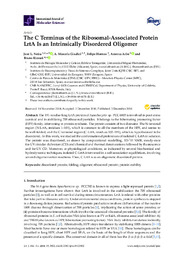Título :
The C Terminus of the Ribosomal-Associated Protein LrtA Is an Intrinsically Disordered Oligomer |
Autor :
Neira Faleiro, José Luis
Giudici, Ana Marcela
Hornos, Felipe
Arbe, Arantxa
Rizzuti, Bruno |
Editor :
MDPI |
Departamento:
Departamentos de la UMH::Agroquímica y Medio Ambiente |
Fecha de publicación:
2018-12-05 |
URI :
https://hdl.handle.net/11000/35642 |
Resumen :
The 191-residue-long LrtA protein of Synechocystis sp. PCC 6803 is involved in post-stress
survival and in stabilizing 70S ribosomal particles. It belongs to the hibernating promoting factor
(HPF) family, intervening in protein synthesis. The protein consists of two domains: The N-terminal
region (N-LrtA, residues 1–101), which is common to all the members of the HPF, and seems to
be well-folded; and the C-terminal region (C-LrtA, residues 102–191), which is hypothesized to be
disordered. In this work, we studied the conformational preferences of isolated C-LrtA in solution.
The protein was disordered, as shown by computational modelling, 1D-1H NMR, steady-state
far-UV circular dichroism (CD) and chemical and thermal denaturations followed by fluorescence
and far-UV CD. Moreover, at physiological conditions, as indicated by several biochemical and
hydrodynamic techniques, isolated C-LrtA intervened in a self-association equilibrium, involving
several oligomerization reactions. Thus, C-LrtA was an oligomeric disordered protein.
|
Palabras clave/Materias:
disordered protein
folding
oligomer
ribosomal protein
protein stability |
Área de conocimiento :
CDU: Ciencias puras y naturales |
Tipo de documento :
info:eu-repo/semantics/article |
Derechos de acceso:
info:eu-repo/semantics/openAccess
Attribution-NonCommercial-NoDerivatives 4.0 Internacional |
DOI :
https://doi.org/10.3390/ijms19123902 |
Publicado en:
International Journal of Molecular Science 2018, 19(12), 3902 |
Aparece en las colecciones:
Artículos Agroquímica y Medio Ambiente
|
 La licencia se describe como: Atribución-NonComercial-NoDerivada 4.0 Internacional.
La licencia se describe como: Atribución-NonComercial-NoDerivada 4.0 Internacional.
.png)
